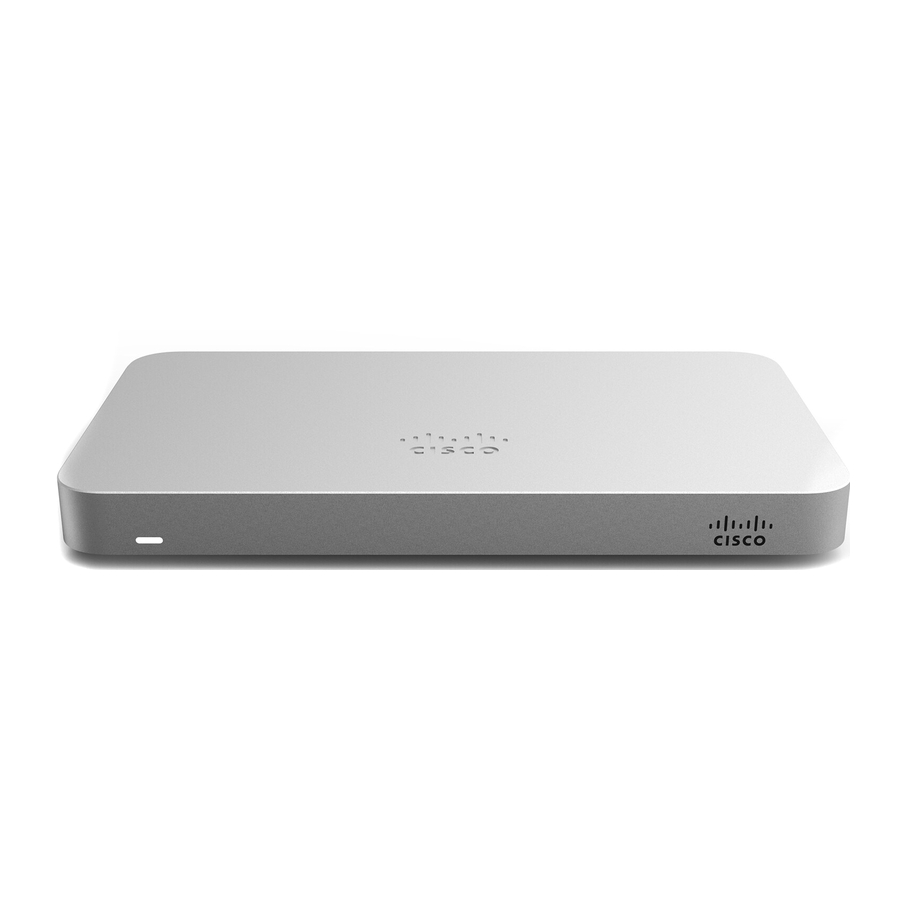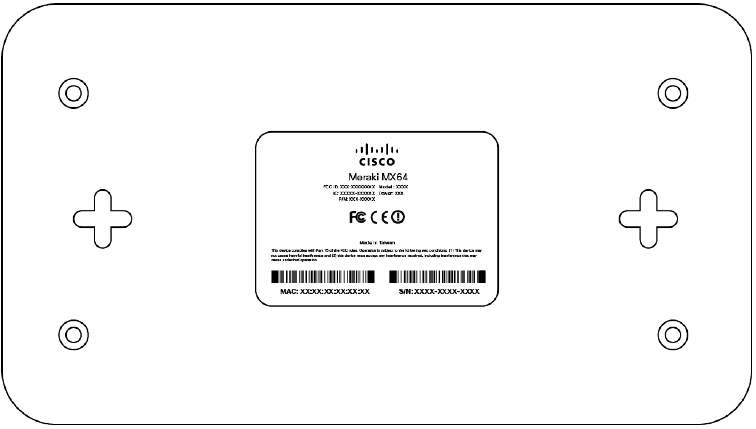
Cisco Meraki MX64 Manual
- Installation manual (7 pages) ,
- Installation manual (5 pages) ,
- Installation manual (6 pages)
Advertisement

MX64 Overview
Note - The MX18.1 firmware release will be the maximum running build for MX64, MX64W, MX65, MX65W, MX84, MX100, and vMX100 platforms. These platforms will not run MX 18.2 and above firmware builds. We recommend you stay up to date with all the latest features with the next-generation hardware platforms. Please consult your sales representative for more information on the latest hardware and software releases.
The Meraki MX64 is an enterprise security appliance designed for distributed deployments that require remote administration. It is ideal for network administrators who demand both ease of deployment and a state-of-the-art feature set. This appliance provides the following new features:
- USB port, to support approved 3G/4G cards for failover to cellular networks.
- Support for four LAN connections
- Wall screws and anchors for mounting drywall surface, either vertically or horizontally
Package contents
In addition to the MX64, the following are provided.

The MX64 front panel

Status Indicator
The MX64 uses an LED to inform the user of the device's status. LED patterns and their meanings are described below.
| LED Status | Meaning |
| Solid orange | Power is applied but the appliance is not connected to the Meraki Dashboard |
| Rainbow Colors | The appliance is attempting to connect to Meraki Dashboard |
| Flashing White | Firmware upgrade in progress |
| Solid White | Fully operational |
The MX64 back panel

Additional functions on the back panel are described below, from left to right.
| USB port | USB 2.0 for 3G/4G wireless cards. Traffic status is indicated by the USB LED. |
| LAN ports | These 4 ports provide connectivity to computers, printers, access points, or Ethernet switches. A steady green LED indicates bidirectional connectivity. The LAN4 port can either be a LAN port or a second Internet port. |
| WAN / Internet port | Provides connectivity to the WAN. |
| Reset button | Insert a paper clip if a reset is required.
|
| Power input | Designed for use only with the unit's power supply. |
The MX64 bottom panel
Please note that the serial number is located on the product label at the bottom panel of MX64

Safety and Warnings
These operations are to be taken with respect to all local laws. Please take the following into consideration for safe operation:
- Power off the unit before you begin. Read the installation instructions before connecting the system to the power source.
- Before you work on any equipment, be aware of the hazards involved with electrical circuitry and be familiar with standard practices for preventing accidents.
- Read the mounting instructions carefully before beginning installation. Failure to use the correct hardware or to follow the correct procedures could result in a hazardous situation to people and damage to the system.
- Please only power the device with the provided power cables to ensure regulatory compliance.
Mounting hardware
The supplied wall screws and anchors allow you to mount the appliance on a drywall surface, either vertically or horizontally. The distance between the holes you drill should be 5-1/8 inches (13 cm).
- For mounting on drywall, use a ¼-in drill bit, then insert the plastic and screw assemblies.
- For mounting on wood or a similar surface, use only the screws.
- Allow the heads of the screws to stick out far enough to be inserted securely into the back of the appliance.
Connecting to WAN
All Meraki MX devices must have an IP address. This section describes how to configure your local area network before you deploy it. A local management web service, running on the appliance, is accessed through a browser running on a client PC. This web service is used for configuring and monitoring basic ISP/WAN connectivity.
Pre-install Preparation
You should complete the following steps before going on-site to perform an installation.
Configure your Dashboard Network
The following is a brief overview only of the steps required to add an MX to your network. For detailed instructions about creating, configuring and managing Meraki networks, refer to the online documentation (documentation.meraki.com).
- Login to http://dashboard.meraki.com. If this is your first time, create a new account.
- Find the network to which you plan to add your MX or create a new network.
- Add your MX to your network. You will need your Meraki order number (found on your invoice) or the serial number of each MX, which looks like Qxxx-xxxx-xxxx, and is found on the bottom of the unit. You will also need your Enterprise license key, which you should have received via email.
- Go to the map / floor plan view and place each MX on the map by clicking and dragging it to the location where you plan to mount it.
Check and Set Firmware
To ensure your MX performs optimally immediately following installation, it is recommended that you facilitate a firmware upgrade prior to mounting your MX.
- Attach your MX to power and a wired Internet connection.
- The MX will turn on and the power LED will glow solid orange.
- If the unit requires an upgrade, the power LED will begin blinking white until the upgrade is complete, at which point the LED will turn solid white. You should allow at least a few minutes for the firmware upgrade to complete, depending on the speed of your internet connection.
Check and Configure Upstream Firewall Settings
If an upstream firewall is already in place, it must allow outgoing connections on particular ports to particular IP addresses. The most current list of outbound ports and IP addresses for your particular organization can be found on the firewall configuration page in your dashboard.
Setting up a static IP address

Do the following to configure basic connectivity and other networking parameters:
- Using a client machine such as a laptop, connect to one of the four LAN ports of the MX.
- Using a browser on the client machine, access the appliance's built-in web service by browsing to http://setup.meraki.com. (You do not have to be connected to the Internet to reach this address)
- Click Uplink configuration under the Local status tab. The default credentials use the device serial number as the username, with a blank password field.
- Choose Static for the IP Assignment option.
- Enter the IP address, subnet mask, default gateway IP and DNS server information.
Setting up a DHCP IP address
By default all MX devices are configured to DHCP from upstream WAN / ISP servers. Simply plug the MX's WAN / Internet port to your upstream circuit and wait a few minutes for the unit to negotiate a DHCP address.

Additional settings

Setting VLANs
If your WAN uplink is on a trunk port, choose VLAN tagging > Use VLAN tagging and enter the appropriate value for VLAN ID for your network.
Setting up secondary WAN interface (dual WAN)
You can toggle the LAN4 port between LAN and Internet/WAN through the Local Status Page or in dashboard under Security & SD-WAN > Monitor > Appliance Status > Uplink tab "Add another WAN port..."
Setting PPPoE
PPPoE authentication may be required if you are connecting MX device to a DSL circuit. You need to know your authentication option and credentials (supplied by your ISP) in order to complete these steps.
- Choose Connection Type > PPPoE.
- Select your Authentication option.
- If you select Use authentication, enter appropriate values for Username and Password.
Web proxy settings
These settings take effect if the MX device has to fall back to using HTTP to contact the Cloud Controller. By default, web proxy is disabled. To enable web proxy, do the following:
- Choose Web proxy > Yes.
- Enter values as appropriate for Hostname or IP and Port.
- If you require authentication, choose Authentication > Use authentication, and enter appropriate values for Username and Password.

Configuring physical link settings
To configure physical link settings on the Ethernet ports, click Local status > Ethernet configuration. You can enable half duplex, full duplex, and autonegotiation, as well as set 10- or 100-Mbps data rates.
Basic Troubleshooting
The following steps can be used for troubleshooting basic connectivity issues with your MX.
- Reset the MX
- Factory reset the MX by holding the factory reset button for 5 seconds
- Try switching cables, or testing your cable on another device
Reference https://documentation.meraki.com/MX for additional information and troubleshooting tips.
If you are still experiencing hardware issues, please contact Cisco Meraki support by logging in to dashboard and using the Help option near the top of the page, then opening and email case or calling using the contact information.
Documents / Resources
References
![documentation.meraki.com]() Home - Cisco Meraki Documentation
Home - Cisco Meraki Documentation![dashboard.meraki.com]() Meraki Dashboard Login
Meraki Dashboard Login![dashboard.meraki.com]() Meraki Dashboard Login
Meraki Dashboard Login![setup.meraki.com]() Cisco Meraki
Cisco Meraki![documentation.meraki.com]() MS - Switches - Cisco Meraki Documentation
MS - Switches - Cisco Meraki Documentation
Download manual
Here you can download full pdf version of manual, it may contain additional safety instructions, warranty information, FCC rules, etc.
Advertisement













Need help?
Do you have a question about the Meraki MX64 and is the answer not in the manual?
Questions and answers